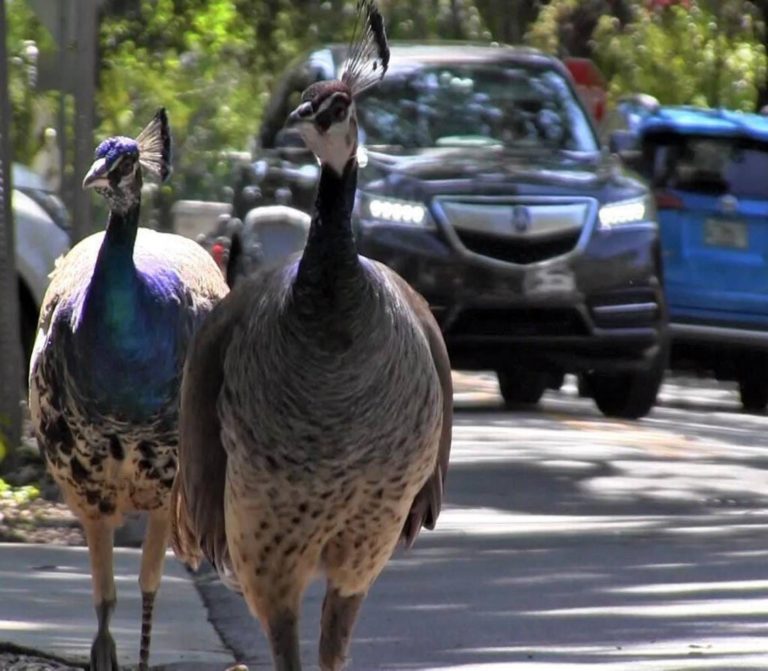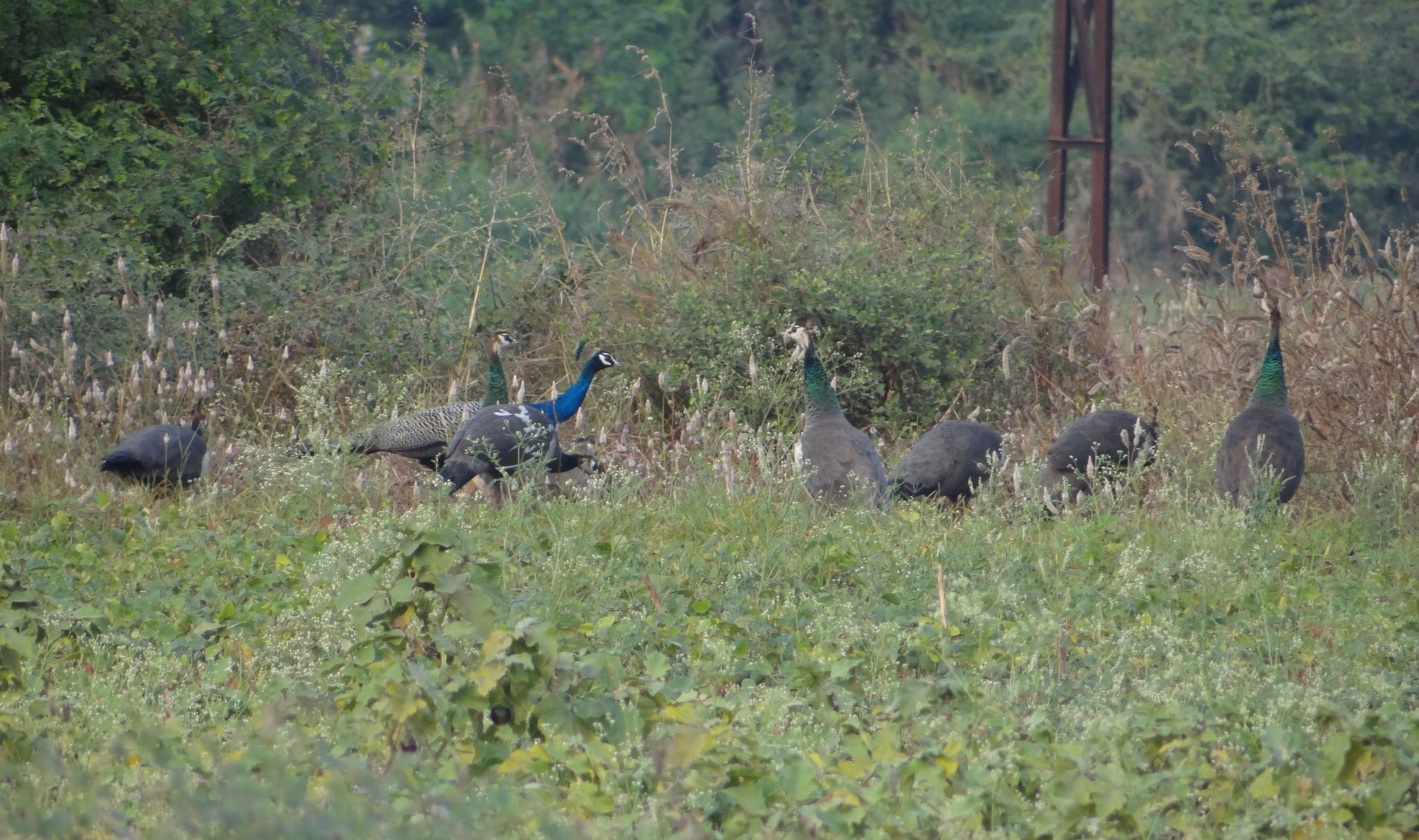- Sri Lanka has a long list of pests, among them the Indian peafowl (Pavo cristatus), a protected species of significant cultural and religious importance to the country’s Buddhist and Hindu populations.
- Peafowls, among the largest member of the pheasant family, reproduce quickly and have spread throughout the island as their natural predators have waned, due largely to human activity.
- Researchers warn that delays in taking long- and short-term action to get the peafowl population under control will result in increasingly severe damage to farmers’ crops and loss of ecological integrity in the rainforests and other sensitive ecosystems where the species is an ecological pest.
- This post is a commentary. The views expressed are those of the author, not necessarily Mongabay.
What is a pest? It implies a value judgment: harmful to whom?
A pigeon is not harmful to the pigeon hawk. But let feral populations multiply in cities, where they and their nests foul human structures, and they are considered pests. Tourists pay to see wild elephants and monkeys, but when they come into your rice paddy or home garden, it becomes an emergency. Introduced species, without their natural predators and diseases, can quickly become ecological pests by outcompeting or preying on native species. Even native species can become pests when their natural habitats have been degraded and destabilized by humans.
Introduced pests
Sri Lanka has a long list of pests, among them the apple snail, giant snail, rainbow trout, knifefish, marble catfish, janitor fish, and red-eared slider turtles. They are not pests in their native countries or in their original habitats, but when they are moved to new habitats they can become ecological pests. Some native animals, such as wild boars, crested porcupines, house crows, and spotted deer, or chital, have also crossed that line. The newest member added to the list is the Indian peafowl (Pavo cristatus). Although native to the Indian subcontinent, including Sri Lanka, it has been widely introduced to other parts of the world.
It was formerly restricted to limited habitats in dry and arid zone forests in Sri Lanka, especially in the southeastern lowlands, but pressures from growing human populations have pushed the peafowl into wetter zones, including rainforests. Recently it has invaded the entire country except Colombo, the capital. Weighing more than 5 kilograms (12 pounds), it is the largest and heaviest member of the pheasant family (Phasianidae), except for North America’s wild turkeys.
A diurnal bird, it spends the day foraging and roosts in groups — noisily — in tall trees at night. It reproduces quickly, reaching sexual maturity within two years and laying seven or eight eggs at a time, which take a month to hatch. It lives up to 15 years in the wild. This highly adaptable bird consumes a vast range of foods, including seeds, insects, fruits, reptiles and small mammals.

Shrinking predator populations
In their intact, native habitats, peafowl populations are controlled by predators such as leopards, jackals, hawk-eagles, mongooses and pythons; monitor lizards and other reptiles are also egg predators. But where humans have driven down predator populations, the peafowl’s adaptability and high reproductive potential (forces of natural selection) have resulted in rapid population growth. The spread of arid zones resulting from human disturbance has also encouraged the spread of peafowl populations.
During the past decade, the overbreeding populations became an agro-pest, damaging crops such as groundnuts, tomatoes, rice paddies, chilis, watermelons, long beans, and even bananas. The peafowl is already identified as the top agro-pest in Sri Lanka.
But as the species is protected by law, farmers do not dare kill them openly; and there is a religious-cultural aspect linked to this conservation issue.
In Hinduism, the god of destruction, Lord Shiva, has two sons. The elder, Kartikeya or Murugan, is one of the more powerful gods in Hindu canon, the god of war, believed to reside in Kataragama, southeastern Sri Lanka. Kartikeya is revered not only by Hindus, but by most Buddhists, who comprise the majority of Sri Lankans. Kartikeya’s vahana, or divine vehicle, is the peafowl, and the powerful deity is always symbolized mounted on a peacock.
Due to respect for (or the fear of) this deity, many people are loathe to eat peafowl. (Doing so is also illegal in Sri Lanka.) However, the peafowl has no restrictions and eats almost anything in sight.
A flock of peafowls, each 10 times the size of a domestic chicken, can destroy a patch of habitat or a crop within a couple of hours. When a legally protected pest belongs to a god, from whom may farmers seek help?
When a pest belongs to a god
The reluctance by the farmers to take action to control the rapid population growth of peafowls is largely influenced by this religious and cultural inhibition.
Ironically, the vahana of Kartikeya’s brother, Ganesha, is Dinka the mouse, representing speed and sharpness — another pest, but one that is trapped and killed daily in rural and urban households.
There are only two ways to reduce the size of a species’ population: mortality (or other cause of reduced recruitment) and emigration. The latter is the permanent movement of individuals out of a population. But since Sri Lanka is an island, the solution must involve mortality.
It has been more than three years since peafowls were identified as an ecological pest. Even though Buddhists understand that death is a common truth for any living organism, culling is not accepted by the Buddhist-majority society. If culling is not accepted, the relevant authorities collaborating with environmentalists must find a quick solution, because animal welfare activists have no practical solutions to the problems.
If the government does not find a solution, farmers may start killing peafowls despite their holiness, as they have no alternative to protect their crops.
Where damage is severe, poisoning and killing for meat has been observed. Although the majority of Sri Lankans are Buddhist, per capita meat consumption was 7.1 kg (15.5 lb) per year in 2013.

Consuming ‘holy meat’
With the current price of chicken at $4 per kg, poachers can get peafowl meat for free, even though it is a “holy meat.”
Therefore, temporary removal of the peafowl from the protected list may reduce the pressure on farmers, as it did with wild boars.
Culling on farmlands will not permanently solve the problem, as the fowls have already invaded rainforests. It is no use closing the stable door after the horse has bolted. Since native snakes, lizards, frogs and small mammals have become regular prey for peafowls, this is a major threat to the biodiversity that remains in highly fragmented rainforest patches in the wet zone.
The wet zone has already been highly degraded by unplanned development projects since independence in 1948. Even though degradation started during the colonial period, unsustainable massive developments — airports, harbors, highways, buildings, and so on — increased in the 1980s and accelerated in the 2000s.

Culling as a temporary solution
Damage to open grasslands, wetlands and marshes in both dry and wet zones caused most natural peafowl predators to become locally extinct or greatly reduced. For an example, jackals, which maintain food chains and stabilize prey populations, declined significantly.
There were news reports recently that an airplane hit a jackal while landing at Mattala International Airport in southern Sri Lanka. In addition to these massive projects, the dredging and draining of wetlands, the discharge of industrial effluents, sewage, garbage disposal and agrochemical runoff, and hydrological modifications have accelerated the shrinking rate of predator populations.
With culling as a temporary solution, a permanent solution is to enrich the predator habitats and enforce hunting laws for sustainable conservation. Although predation is a natural way to reduce a prey population, the response is slower than culling. It will take at least 10 years to show any progress of population decline of peafowls.
It is impossible to think that the government will undo all developments and enrich jackal habitats, even if it is the same wish of the public.
However, any delay in taking long-term or short-term action will result in severe crop damage and loss of ecological integrity. The decline of endemic biodiversity at alarming rates, especially of endemic snakes, may result in the overbreeding of other pests too, like mice and rats, which are controlled by snakes.
Failure to urgently address the problem of peafowls will create fresh problems.
A.A. Thasun Amarasinghe is a herpetologist, taxonomist, ecologist and conservation scientist currently working as a senior research scientist at the Research Center for Climate Change–University of Indonesia. He has published nearly 100 research articles on biodiversity, ecology, biogeography, taxonomy, and conservation, and introduced more than 15 new species to science from Sri Lanka, India, Indonesia and Vietnam.
References
Alahakoon, A. U., Jo, C., & Jayasena, D. D. (2016). An overview of meat industry in Sri Lanka: A comprehensive review. Korean Journal for Food Science of Animal Resources, 36(2), 137–144. doi:10.5851/kosfa.2016.36.2.137
Clothey, F.W. (1978). The Many Faces of Murukan: The History and Meaning of a South Indian God. Berlin, Germany: Walter de Gruyter.
Jordania, J. (2011). Peacock’s Tail: Tale of Beauty and Intimidation. In Why do People Sing? Music in Human Evolution (pp. 192-196). Tbilisi, Georgia: Logos.
Lowe, S., Browne, M., Boudjelas, S., & De Poorter, M. (2000). 100 of the world’s worst invasive alien species: A selection from the Global Invasive Species Database. The Invasive Species Specialist Group (ISSG), Species Survival Commission (SSC), World Conservation Union (IUCN).
Trivedi, P., & Johnsingh, A. J. T. (1995). Diet of Indian peafowl Pavo cristatus Linn in Gir Forest, Gujarat. Journal of Bombay Natural History Society, 92(2), 262-263.
Whistler, H. (1949). Popular Handbook of Indian Birds. London, U.K.: Gurney and Jackson.
Banner image of an Indian peafowl at the Yala National Park in southern Sri Lanka, by Geoff Brooks via Splash.
